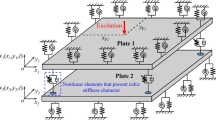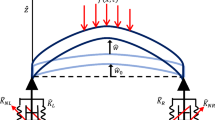Abstract
The present paper is concerned with the numerical analysis of the steady-state and transient response of thin elastic plates. Based on a modification of the variational principle due to Hamilton wherein in contrast to the classical formulation not only displacements but also stress resultants represent independent (primal) variables, a new mixed hybrid finite element model is proposed. Introducing separate approximations for the displacement and stress field, stiffness and consistent mass matrix of a triangular plate element with three kinematic degrees of freedom per nodal point are obtained. The performance of the new element scheme is evaluated on the basis of several test examples representing a broad range of circumstances encountered in linear elastokinetic thin plate analysis. The obtained numerical results demonstrate that in terms of efficiency, reliability and accuracy the new element scheme competes most favorably with a series of well-established plate elements.
Similar content being viewed by others
References
Leissa, A.W.: Vibration of plates. Report NASA SP-160, Washington, D.C. 1969.
Malsch, H.: Stabilitäts- und Schwingungsuntersuchungen von ausgesteiften Platten nach einer Finite-Element-Methode. Diss. TU Braunschweig 1977.
Dungar, R., R.T. Severn andP.R. Taylor: Vibration of plate and shell structures using triangular finite elements. J. Strain Analysis Vol. 2 (1967) pp. 73/83.
Röhrle, H.: Reduktion von Freiheitsgraden bei Strukturdynamik-Aufgaben. Forschr.-Ber. VDI-Z., Ser. 1/72. Düsseldorf: VDI-Verlag, 1980.
Talaslidis, D.: Inkrementelle Schalentheorien und numerische Behandlung diskretisierter Eigenwertprobleme der Strukturmechanik auf der Grundlage verallgemeinerter Arbeitsaussagen. Diss. Ruhr-Univ. Bochum 1978.
Barnard, A.J. andP.W. Sharman: Elasto-plastic response of plates to blast loading. Report AD TT 7313, Laughborough Univ. 1973.
Dirr, B. andH. Waller: Zum Problem der Berechnung der Eigenfrequenzen und Eigenformen elastischer ebener Kontinua. Ingenieur-Archiv Vol. 43 (1974) pp. 74/91.
Reddy, J.N. andC.S. Tsay: Stability and vibration of thin rectangular plates by simplified mixed finite elements. J. Sound Vibration Vol. 55 (1977) pp. 289/302.
Cowper, G.R., E. Kosko, G.M. Lindberg andM.D. Olson: Static and dynamic applications of a high-precision triangular plate bending element. AIAA J. Vol. 7 (1969) pp. 1957/65.
Minich, M.D. andC.C. Chamis: Doubly-curved variable-thickness isoparametric heterogeneous finite element. Computers & Structures Vol. 7 (1977). pp. 295/301.
Martins, R.A.F. andD.R.J. Owen: Thin plate semiloof element for structural analysis—including stability and natural vibrations. Int. J. num. Meth. Engng. Vol. 12 (1978) pp. 1667/76.
Karamanlidis, D. andH. Le The: Berechnung dünner Plattentragwerke nach dem Finite-Elemente-Verfahren. VDI-Forschungsheft 621. Düsseldorf: VDI-Verlag 1984.
Fried, I.: Residual energy balancing technique in the generation of plate bending finite elements. Computers & Structures Vol. 4 (1974) pp. 771/78.
Tong, P., S.T. Mau andT.H.H. Pian: Derivation of geometric stiffness and mass matrices for finite element hybrid models. Int. J. Solids & Structures Vol. 10 (1974) pp. 919/32.
Prager, W.: Variational principles for elastic plates with relaxed continuity requirements. Int. J. Solids & Structures Vol. 4 (1968) pp. 837/44.
Bufler, H.: Die verallgemeinerten Variationsgleichungen der dünnen Platte bei Zulassung diskontinuierlicher Schnittkräfte und Verschiebungen. Ingenieur-Archiv Vol. 39 (1970) pp. 330/40.
Batoz, J.-L., K.-J. Bathe andL.-W. Ho: A search for the optimum three-node triangular plate bending element. Report No. 82448-8, M.I.T. 1978
MRI/STARDYNE, Static and dynamic structural analysis systems; Finite element demonstration problems. Control Data Corp., Minneapolis 1973.
Au, N.M. andL.S. Gould: ASAS validation manual. Atkins R & D, England 1983.
SESAM '80 acceptance tests. Det Norske Veritas Research Division, Hovik 1983.
PAFEC 75; Theory-results. Nottingham Univ. 1975.
ANSYS engineering analysis system verification manual. Swanson Analysis Systems, Inc. 1976.
Clough, R.W. andC.A. Felippa: A refined quadrilateral element for analysis of plate bending. Proc. 2nd Conference on Matrix Methods in Structural Mechanics, Ohio 1968.
Warburton, A.B. The dynamic behaviour of structures, 2nd ed. Oxford, New York, Toronto, Sydney, Paris, Frankfurt: Pergamon Press 1976.
Tabarrok, B. andD.S. Sodhi: On the generalization of stress function procedure for dynamic analysis of plates. Report UTME-TP 7201, Univ. Toronto 1972.
Tabarrok, B.: Complementary energy method in elastodynamics. Report UTME-TP 7101, Univ. Toronto 1971.
Sakaguchi, R.L. andB. Tabarrok: Calculations of plate frequencies from complementary energy formulation. Int. J. num. Meth. Engng. Vol. 2 (1970).
Goudreau, G.L. andR.L. Taylor: Evaluation of numerical integration methods in elastodynamics. Comp. Meths. Appl. Mech. Eng. Vol. 2 (1972) pp. 69/97.
Nickell, R.E.: Direct integration methods in structural dynamics. J. Eng. Mech. Div., ASCE Vol. 99 (1973) pp. 303/17.
McNamara, J.F.: Solution schemes for problems of nonlinear structural dynamics. J. Pressure Vessel Tech., ASME Vol. 97 (1974) pp. 96/102.
Gorman, D.J.: Free vibration analysis of rectangular plates. New York, Amsterdam, Oxford: Elsevier 1982.
Bathe, K.-J. andS. Bolourchi: A geometric and material nonlinear plate and shell element. Computers and Structures Vol. 11 (1980) pp. 23/48.
Author information
Authors and Affiliations
Additional information
This work was partially supported by the Deutsche Forschungsgemeinschaft.
Rights and permissions
About this article
Cite this article
Karamanlidis, D. A pseudo-complementary finite element approach for the vibration analysis of thin plates in bending. Forsch Ing-Wes 51, 69–78 (1985). https://doi.org/10.1007/BF02558400
Received:
Issue Date:
DOI: https://doi.org/10.1007/BF02558400




